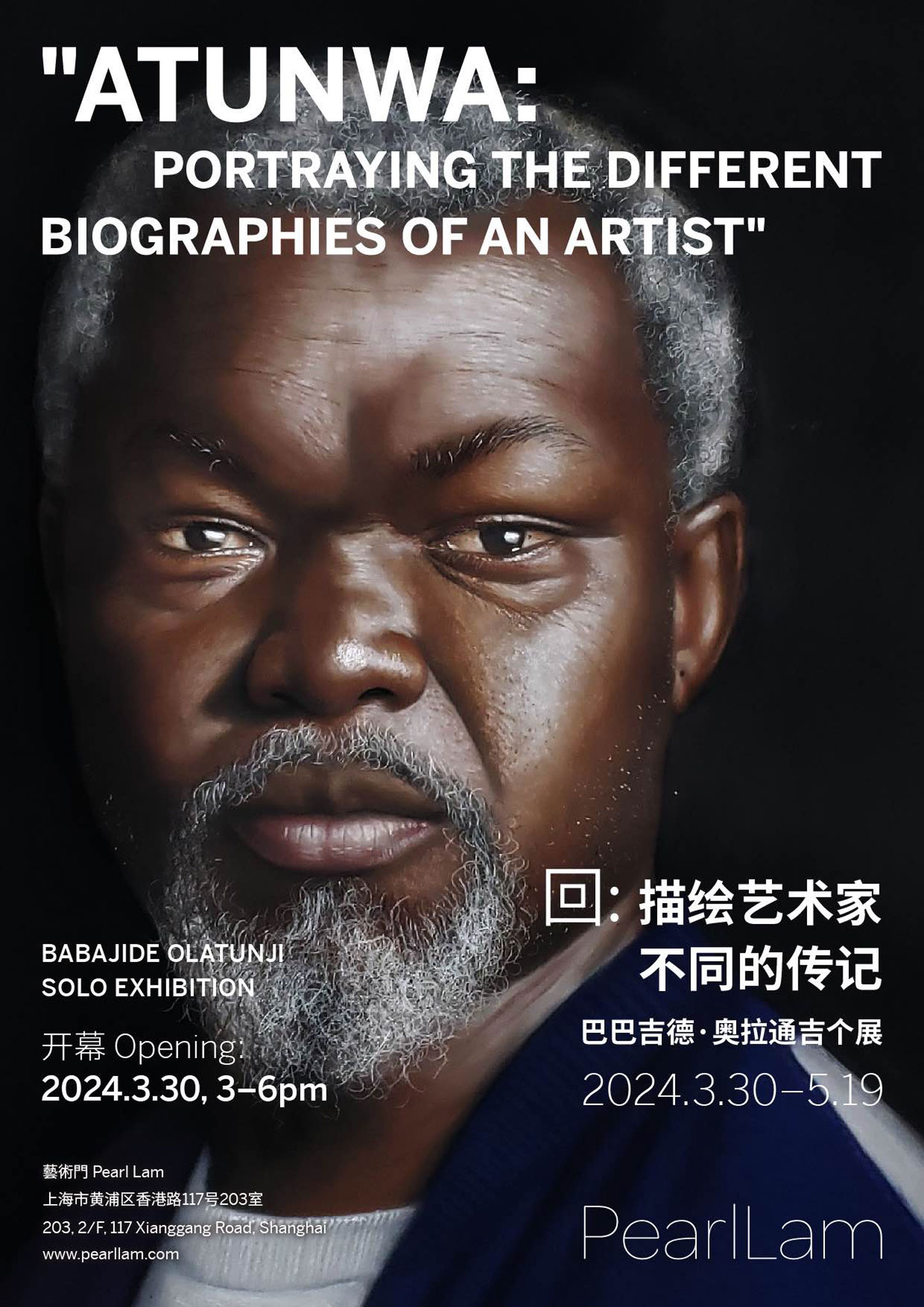展期 Period:
2024.3.30—2024.5.19
艺术家 Artist:
地点 Venue:
新闻稿 Press Release:
上海——藝術門荣幸呈献《回:描绘艺术家不同的传记/巴巴吉德·奥拉通吉个展》。此次展览是生于尼日利亚,现居伦敦的艺术家巴巴吉德·奥拉通吉在藝術門的首次个展,将展出一系列非洲侨民视角下探索我们人类集体经历的迷人肖像。
受到詹姆斯·乔伊斯《一个青年艺术家的画像》的启发,展览标题《回》引用了西非盛行的约鲁巴语言传统,表达了源自Ifa——智慧与智力发展之神——教义的轮回现象,象征着跨越不同时空的超越。
奥拉通吉的艺术实践深深植根于尼日利亚的历史和文化。他拒绝历史修正和身份政治的概念,有意回避殖民化带来的不公正问题。相反,他力图重新定位艺术史,主张无需从殖民历史中夺回任何东西。他的目标是讲述尼日利亚自身的历史,报谢其丰富的世系,并向人类共同的祖先致敬。
通过七个章节的虚构传记,奥拉通吉的绘画展现了非洲侨民不同人物的集体重生,其中每个人物代表不同的社会和道德角色。这些虚构的主体共同充当着社会评论的角色,揭示了由于失落、自我认同、坚持、亲情、女性身份、家庭生活、遏制、社会流动性和知性所产生的心理状态。展览呈现的每个章节都代表一个与艺术家紧密相关的独特个体,是对命运和不同道路的有意识反思。展览通过为每个人物描绘三幅衰老过程,成为一个集体的死亡警示,提醒观众生命的短暂和我们的共同宿命。此外,一些人物面部的划痕也是代表其文化起源的源代码。这些刻在面部的复杂图案彰显了亲密感,突出每个人物的独特个性,邀请观众思考理想化的程度。个别肖像中,闪烁的目光唤起了一种希望和雄心的感觉,暗示着世界一切都好。然而,从被描绘者的眼中也能看到一丝对不确定的未来和日益增加的家庭责任的戒备和恐惧,而略微抿起的嘴唇则为整体表情增添了一丝肃穆。
奥拉通吉说,“我也面临同样的问题:我画的这些人是谁?如果我能坐下来和他们每个人聊天,他们会讲些什么故事呢?或许每件作品都是我向世界散发的一小部分自我。也许他们是其他生命中潜在的化身,我之所以能创造他们,是因为他们对我的身份来说是可识别的。他们是熟悉的,但我并不知道他们是谁。他们都拥有自己的超我,这些超我是由他们的家庭、宗教信仰以及他们出生并成长的社会环境所赋予的。”
通过使用超写实主义,奥拉通吉创造了一种沉浸式体验,将观众带入肖像描绘的叙事中。受卡拉瓦乔、伦勃朗·凡·莱因、迭戈·委拉斯开兹、西奥多·杰利柯等欧洲绘画大师的影响,艺术家使用明暗对照画法来捕捉人物的精髓。通过预设观众的接收和参与,光线和情绪的运用进一步增强了他作品的情感冲击力。奥拉通吉的绘画包含对人物的敏锐观察、细致的线条描绘,以及对面部特征、理想化、肤色、社会阶层、背景和表情的深思熟虑地调整。
《回》提出了关于所描绘对象在不同社会阶层中存在的有趣问题,想象他们将遇到的独特旅程和挑战。这些虚构人物包括骄傲的巴吉女性阿米亚·多卡斯·谢库库苏米,她从祖母讲述的生动的格瓦里文化故事中发现了自己对讲故事的热情。伊呀波·奥拉巴姆克·阿德博瓦莱,一位来自奥约州伊塞因市的歌手/作曲家,在尼日利亚充满活力的强节奏爵士音乐中找到了安慰和热爱,2005年发行第二张专辑时,她的音乐实力终于获得了认可。阿贾迪·埃斯特·欧姆多拉普,一位陶艺家和染工,从小在当地的织工中长大,并掌握了古老的蜡染技艺。丹尼尔·多姆卡特·拉,一位来自工匠世家的木雕师和雕塑家,在桃花心木上精心雕刻复杂的设计。奥奇·桑姆森·巴巴洛拉,一位表演艺术家和传统鼓手,将社会讽刺与神话叙事融合在一起。丹塔拉·丹尼斯·易卜拉欣,一位学者和画家,探索被遗忘的历史和描绘非洲大草原生机勃勃的景观。巴巴吉德·奥拉通吉,艺术家本人,在兄长的启发下,用自己的艺术才能游走于周围的世界并做出贡献。
这次展览不仅传达了艺术家的技术实力和讲故事的能力,也成为了自省和同理心的催化剂。它促使观众思考人类经历的多样性和我们共同人性的相互联系,鼓励人们更深入地理解我们在这个复杂的、日益隔离的世界中所走的不同道路。
Shanghai—Pearl Lam is delighted to announce the upcoming exhibition ATUNWA: Portraying the Different Biographies of an Artist, a solo show by Nigerian-born, London-based artist Babajide Olatunji. This exhibition marks Olatunji’s first solo exhibition with the gallery and will showcase a series of captivating portraitures that explore our collective human experience through the lens of African diaspora.
Inspired by James Joyce’s A Portrait of the Artist as a Young Man, the exhibition title “ATUNWA” references the Yoruba linguistic tradition prevalent in West Africa and expresses the phenomenon of reincarnation derived from the doctrines of Ifa, the deity of wisdom and intellectual development, signifying transcendence across different times and spaces.
Olatunji’s artistic practice is deeply rooted in engaging with Nigerian history and culture. Rejecting the notion of historical revision and identity politics, the artist deliberately turns away from addressing the injustices resulting from colonisation. Instead, he seeks to repurpose art history, asserting that there is no need to reclaim anything from the colonial past. His aim is to tell Nigeria’s own history, acknowledge its rich lineage, and pay tribute to ancestry as something common to humanity.
By staging seven chapters of imaginary biographies with painting, Olatunji presents a collective rebirth of characters from the African diaspora, each embodying different social and moral roles. These fictional subjectivities collectively serve as social commentary, shedding light on psychological states resulting from loss, self-identity, perseverance, kinship, womanhood, domesticity, containment, social mobility, and intellectuality. Each individual chapter presented in the exhibition represents a unique individual closely associated with the artist and is a conscious reflection of fate and different paths. Through the depiction of aging in the three paintings dedicated to each character, the exhibition serves as a collective memento mori, reminding viewers of the transient nature of life and the universal destiny we all share. Furthermore, the facial scarification in some characters functions as a source code representing their cultural origin. The intricate patterns etched on the faces celebrate the intimacy and highlight the individuality of the depicted, inviting viewers to ponder the degree of idealisation. The gleaming gaze in individual portraits evoke a sense of hope and ambition, suggesting that all is right with the world. However, a subtle tinge of wariness and fear about an uncertain future and mounting familial responsibilities can be seen in the subjects’ eyes, while the slightly pinched mouths add a touch of solemnity to the overall expression.
Olatunji states, “I contend with this same question: Who are these people that I paint? If I could sit and chat with each of them, what stories would they tell? Perhaps each work is a little part of myself shed onto the world. Perhaps they are possible incarnates in other lifetimes and I am able to create them because they are recognisable to my identity. They are familiar, but I don’t always know who they actually are. They all possess their own superegos imbued on them by their families, religious affiliations and the society into which they are born and nurtured.”
Through the use of hyperrealism, Olatunji creates an immersive experience, drawing viewers into the narratives depicted in his portraits. Influenced by old European masters including Caravaggio, Rembrandt van Rijn, Diego Velázquez, and Théodore Géricault, the artist employs chiaroscuro painting techniques to capture the essence of his subjects. The use of light and mood further enhances the emotional impact of his works, while postulating the viewer’s reception and engagement. Olatunji’s paintings involve keen observation of his subjects, meticulous line drawings, and thoughtful adjustments to facial features, idealisation, complexion, background, and expression.
Atunwa raises intriguing questions about the existence of Olatunji’s subjects in different social strata, imagining the unique journeys and struggles they would encounter. These fictional characters include Amiya Dorcas Shekwokusumi, a proud Gbagyi woman who discovered her passion for storytelling from her grandmother’s captivating tales of Gwari culture. lyábò Olábámké Adébowálé, a singer/songwriter from Iseyin, Oyo state, found solace and passion in the vibrant world of Nigerian highlife music and finally earned recognition for her musical prowess when her second album released in 2005. Ajadi Esther Omodolapo, a potter and dyer, grew up among local weavers and mastered the ancient art of batik making. Daniel Domkat Lar, a wood carver and sculptor from a lineage of artisans, meticulously crafts intricate designs on blocks of mahogany. Òkè Samson Babalola, a performance artist and traditional drummer, merges social satire with mythological narratives. Dantala Dennis Ibrahim, a scholar and painter, explores forgotten histories and portrays vibrant landscapes of the African Savanna. Babájídé Olatunji, the artist himself, inspired by his elder brother, uses his artistic talents to navigate and contribute to the world around him.
This exhibition not only conveys the artist’s technical prowess and storytelling ability but also serves as a catalyst for introspection and empathy. It prompts viewers to consider the multiplicity of human experiences and the interconnectedness of our shared humanity, encouraging a deeper understanding of the diverse paths we all walk in this complex and increasingly segregated world.

